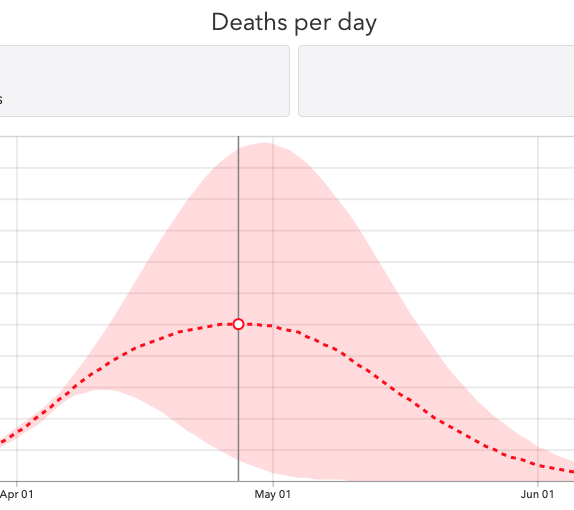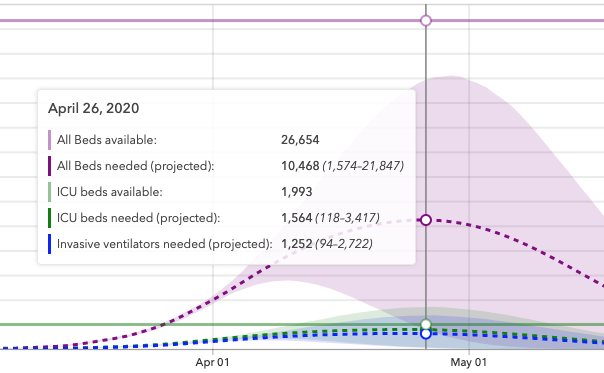The coronavirus crisis will create peak demand on California’s health care resources on April 26, but the state will be likely able to meet the need for hospital beds, according to a state-by-state forecast from researchers at the University of Washington’s medical school.
The Golden State will see more than 4,300 deaths due to coronavirus, with fatalities continuing into August, the forecast found as of Monday. The numbers are expected to peak with about 100 deaths per day in late April.
The state-by-state projections were published last week by the Institute for Health Metrics and Evaluation at the university in Seattle. The modeling is being updated daily, and the figures available for California on Monday show improvement since the forecast’s March 26 release.
The state has been preparing for a surge that will require two-thirds increase in hospital system capacity, Gov. Gavin Newsom said Monday, when a top state health official indicated the state’s own “very dynamic” modeling indicated a peak in the second half of May.

There are now 5,763 positive coronavirus cases in California and 135 people have died, the state announced.
Nationwide, approximately 82,141 people will die from the virus over the next four months, the forecast predicts from a range of 39,174 to 141,995 deaths. Over the weekend, Dr. Anthony Fauci of the National Institutes of Health predicted between 100,000 and 200,000 deaths in the U.S.
California is one of few states expected to meet the need for ICU beds, according to the projections. Forty-one other states will require more intensive-care beds than are currently available, the forecast authors said.
Across the country, demand for ventilators and beds in hospital intensive care units is expected to far exceed capacity when need peaks on April 15, and deaths from the virus will continue into July, the researchers found.
“An estimated need of 224,321 total beds (33,440 for ICU) and 26,753 ventilators at peak could be devastating for hospitals and health workers nationwide,” an update published Monday stated.
The data is based on observed death rates and an expectation of continuing adherence to social distancing guidelines throughout the pandemic — and on states that have not already adopted such measures doing so within the next week.
“Our estimated trajectory of COVID-19 deaths assumes continued and uninterrupted vigilance by the general public, hospital and health workers, and government agencies,” said institute director Dr. Christopher Murray in a news release. “The trajectory of the pandemic will change — and dramatically for the worse — if people ease up on social distancing or relax with other precautions.”
Projections for California
California’s peak is 11 days behind the U.S. average, which should occur April 15, according to the institute’s projections.
At the predicted April 26 peak, California will have enough ICU beds to meet peak demand for COVID-19 patients, with 1,564 intensive care beds needed out of 1,993 available, the forecast stated.
A worst-case projection, however, shows the state falling far short of a possible 3,417 ICU beds needed.
The total number of hospital beds needed for COVID-19 patients in California is expected to peak at 10,468, with 26,654 available, according to the forecast. The worst-case projection is for 21,874 hospital beds needed, still within the available range.

Newsom said Monday that the number of hospitalizations in California doubled and the number of intensive care patients tripled in the last four days.
California is aiming to increase hospital bed capacity by 50,000 and to have 10,000 ventilators available, he said.
“On the physical asset side — that surge of 50,000 beds — we’re making real progress,” Newsom said.
The state will need 1,252 ventilators at peak, according to the forecast. The state had 4,252 ventilators as of Monday, the governor said.
As of Monday, 1,432 people are hospitalized in California due to to COVID-19, with 597 in the ICU, Newsom said.
In response to a question about when the state will see peak hospitalizations, Newsom said that would be determined in part by successful social distancing and adherence to his stay-at-home order.
Newsom said the state is using a “dynamic model” that has changed “radically” in the past few days. He declined to give a specific date, but California Health and Human Services Secretary Dr. Mark Ghaly said the state’s modeling indicates a peak in the latter half of May.
“We are constantly reassessing,” Ghaly said. “These numbers are very dynamic.”
California possibly more prepared
The University of Washington data shows California better off than many other states. New York is in the worst shape.
New York will need 11,070 ICU beds at its predicted April 9 peak, but only has 718 available. In the worst-case projection, the state could need more than 17,000 ICU beds. It will be short more than 58,000 hospital beds overall — the most in the nation, the forecast found.
Makeshift hospitals were being set up in tents in New York City’s famed Central Park over the weekend.
Meanwhile, at the Port of Los Angeles, the USNS Mercy arrived last week to accommodate 1,000 hospital patients who are not being treated for coronavirus. The Los Angeles Convention Center will also be converted into a field hospital, L.A. Mayor Eric Garcetti said Sunday — and that’s just one of several similar sites being set up across the state.
Key to meeting health care demand is the creation of such field hospitals, delay in elective procedures, an increase bed numbers above licensed capacity, and a reduction in staff-to-patient ratios, the institute said.
Despite uncertainty, California appears on ‘slow trajectory’
It was not immediately clear if the University of Washington analysis took into account recently announced state government plans to surge hospital capacity.
The data available Monday shows a significant reduction in the number of California hospital beds needed that was reported soon after the projection became available last week.
The Los Angeles Times reported Saturday that the forecast showed 150 deaths per day in California at peak; as of Monday that projection had dropped by a third.
There’s considerable uncertainty in the University of Washington forecast, the researchers told the Times.
But it’s clear California is on a different path than many other states.
“What we think we’ll see is a quite late peak in the epidemic in California, and that’s because there’s been a very slow trajectory of growth — of deaths and cases in California,” Murray, the institute’s director, told the Times. “And that may be because of earlier social distancing. We don’t know. But certainly it is not the trajectory we’re seeing in New York, or Louisiana, or Georgia, for example.”
Los Angeles County predictions coming
Asked about predictions of a peak date in late April, the director of Los Angeles County’s Department of Public Health said her agency was planning to release a full report this week with modeling using its own numbers.
“The truth of the matter is none of us really know,” Dr. Barbara Ferrer said. “We’re all making the best guess that we can using the different modeling techniques that are available.”
The fact that no one has ever experienced this virus before makes it very difficult to make accurate predictions, but we’ll know more when we see this week if county rates continue to double or triple, she said.
She praised those in the nation’s most populous county — with some 10 million residents — for practicing social distancing and isolation.
“If we’re really good at this … we might have a different trajectory here in L.A. County,” Ferrer said. “I don’t know for sure, but that’s the hope I offer: Let’s get really good at what we know we can do to dampen the curve.”
Asked specifically about the University of Washington forecast, L.A. Mayor Eric Garcetti said the city’s experts had told him it was “very rigorous.”
“It’s not the only thing. I wouldn’t take any of these numbers as gospel,” Garcetti said. “These are projections that help us plan.”












